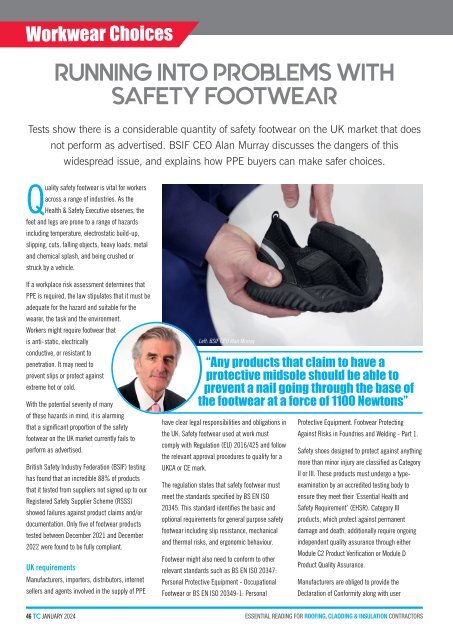January 2024
You also want an ePaper? Increase the reach of your titles
YUMPU automatically turns print PDFs into web optimized ePapers that Google loves.
Workwear Choices<br />
RUNNING INTO PROBLEMS WITH<br />
SAFETY FOOTWEAR<br />
Tests show there is a considerable quantity of safety footwear on the UK market that does<br />
not perform as advertised. BSIF CEO Alan Murray discusses the dangers of this<br />
widespread issue, and explains how PPE buyers can make safer choices.<br />
Quality safety footwear is vital for workers<br />
across a range of industries. As the<br />
Health & Safety Executive observes, the<br />
feet and legs are prone to a range of hazards<br />
including temperature, electrostatic build-up,<br />
slipping, cuts, falling objects, heavy loads, metal<br />
and chemical splash, and being crushed or<br />
struck by a vehicle.<br />
If a workplace risk assessment determines that<br />
PPE is required, the law stipulates that it must be<br />
adequate for the hazard and suitable for the<br />
wearer, the task and the environment.<br />
Workers might require footwear that<br />
is anti-static, electrically<br />
conductive, or resistant to<br />
penetration. It may need to<br />
prevent slips or protect against<br />
extreme hot or cold.<br />
With the potential severity of many<br />
of these hazards in mind, it is alarming<br />
that a significant proportion of the safety<br />
footwear on the UK market currently fails to<br />
perform as advertised.<br />
British Safety Industry Federation (BSIF) testing<br />
has found that an incredible 88% of products<br />
that it tested from suppliers not signed up to our<br />
Registered Safety Supplier Scheme (RSSS)<br />
showed failures against product claims and/or<br />
documentation. Only five of footwear products<br />
tested between December 2021 and December<br />
2022 were found to be fully compliant.<br />
UK requirements<br />
Manufacturers, importers, distributors, internet<br />
sellers and agents involved in the supply of PPE<br />
Left: BSIF CEO Alan Murray<br />
“Any products that claim to have a<br />
protective midsole should be able to<br />
prevent a nail going through the base of<br />
the footwear at a force of 1100 Newtons”<br />
have clear legal responsibilities and obligations in<br />
the UK. Safety footwear used at work must<br />
comply with Regulation (EU) 2016/425 and follow<br />
the relevant approval procedures to qualify for a<br />
UKCA or CE mark.<br />
The regulation states that safety footwear must<br />
meet the standards specified by BS EN ISO<br />
20345. This standard identifies the basic and<br />
optional requirements for general purpose safety<br />
footwear including slip resistance, mechanical<br />
and thermal risks, and ergonomic behaviour.<br />
Footwear might also need to conform to other<br />
relevant standards such as BS EN ISO 20347:<br />
Personal Protective Equipment - Occupational<br />
Footwear or BS EN ISO 20349-1: Personal<br />
Protective Equipment. Footwear Protecting<br />
Against Risks in Foundries and Welding - Part 1.<br />
Safety shoes designed to protect against anything<br />
more than minor injury are classified as Category<br />
II or III. These products must undergo a typeexamination<br />
by an accredited testing body to<br />
ensure they meet their ‘Essential Health and<br />
Safety Requirement’ (EHSR). Category III<br />
products, which protect against permanent<br />
damage and death, additionally require ongoing<br />
independent quality assurance through either<br />
Module C2 Product Verification or Module D<br />
Product Quality Assurance.<br />
Manufacturers are obliged to provide the<br />
Declaration of Conformity along with user<br />
46 TC JANUARY <strong>2024</strong>
















